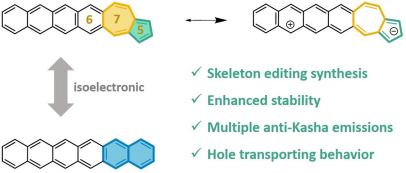Graphene nanoribbons (GNRs) and nanographenes (NGs) based on benzenoid rings possess enormous potential as next-generation semiconductor materials due to their tunable bandgaps and attractive electronic properties. The incorporation of non-benzenoid rings into GNRs/NGs breaks down the ideal hexagonal lattice contributing to the electronic property modulation as well as to important aspects such as solubility, stability, and reactivity. Azulene, a non-benzenoid aromatic hydrocarbon with distinctive 5-7 topology, possesses unique properties including a large dipole moment and anti-Kasha emission. Azuacenes, defined as azulene fused with acenes in a 6-7-5 ring topology have emerged with a dual purpose, either as representative models of defective GNRs and as valuable materials for organic optoelectronics.

Recently, Cheng Zhang/Jingsong You et al. in the College of Chemistry, Sichuan University, in collaboration with Professor Juan Casado in the University of Málaga, Spain, present a bottom-up synthesis approach for the preparation of azuacenes (nAzus, n=2-6) through simultaneous skeletal editing and [3+2] annulation strategy. For the same number of rings, azuacenes improve the chemical stability of acenes (i.e., smaller diradical character) and their photophysical properties (i.e., anti-Kasha emissions and modulation of the energy and strength of the visible bands). Meanwhile, nAzus also display the ability as hole transporting semiconductors in analogy to acenes.
This work is published on Journal of the American Chemical Society, titled as “Optimal Synergy between Azulenes and Acenes in Azuacenes with 6‑7‑5 Ring Topology”. Sichuan University is top institute in the address list. Prof. Cheng Zhang, Prof. Jingsong You and Prof. Juan Casado are corresponding authors, Ph.D. candidate Fei Huang and Marcos Díaz-Fernández contribute equally to this work as co-first authors. This work is financially supported by the National Natural Science Foundation of China, the Sichuan Science and Technology Program, and the Fundamental Research Funds for the Central Universities.
